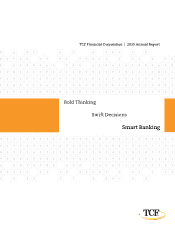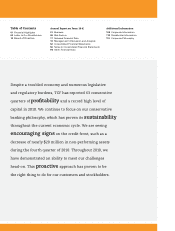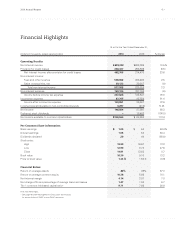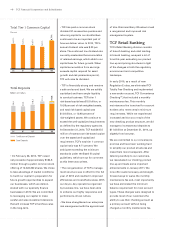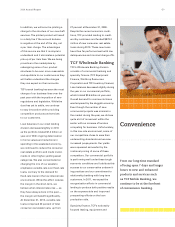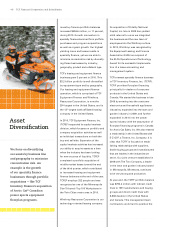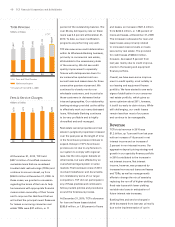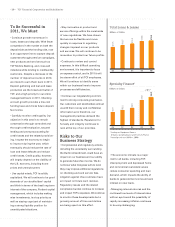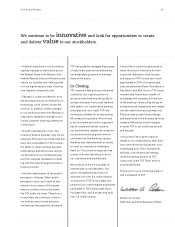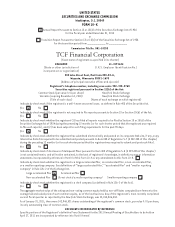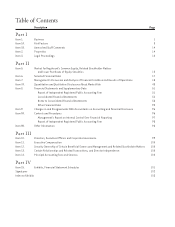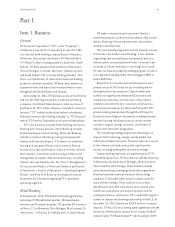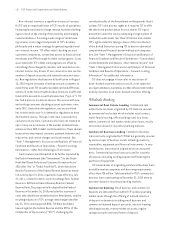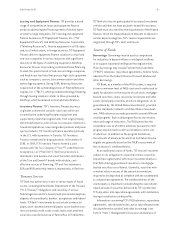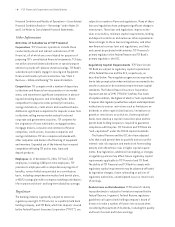TCF Bank 2010 Annual Report Download - page 10
Download and view the complete annual report
Please find page 10 of the 2010 TCF Bank annual report below. You can navigate through the pages in the report by either clicking on the pages listed below, or by using the keyword search tool below to find specific information within the annual report.
At December 31, 2010, TCF held
$337.4 million of modified consumer
real estate loans that are considered
troubled debt restructurings (TDRs) and
continue to accrue interest, up from
$252.5 million at December 31, 2009. In
these cases, we granted a concession
regarding the terms of the loan to help
homeowners with appropriate financial
means retain ownership of their house
and to improve the likelihood that we
will collect the principal owed. Reserves
for losses on accruing consumer real
estate TDRs were $37 million, or 11
percent of the outstanding balance. The
over 60-day delinquency rate on these
loans was 5.3 percent at December 31,
2010. To date, our loan modification
programs are performing very well.
TCF also saw some credit deterioration
within its Wholesale Banking business,
primarily in commercial real estate,
attributable to the recessionary state
of the economy. We did see credit
quality improvement in specialty
finance with delinquencies down for
six consecutive quarters and non-
accrual loans and leases down for three
consecutive quarters at year-end. We
continued to closely monitor our
wholesale customers, and in particular
those customers in distressed indus-
tries and geographies. Our relationship
banking strategy provided us the ability
to effectively work out many distressed
loans. Wholesale Banking continues
to be very profitable and is highly
diversified and well-managed.
Real estate owned properties and real
estate in judgment properties increased
over the past year as the length of time
in the foreclosure process continues to
expand. Delays in TCF’s foreclosure
process are not due to any failures in
our system to comply with regional
laws, like the robo-signer debacle at
other banks, but were affected by an
overwhelmed legal system in some
markets. The foreclosure crisis of 2010
involved misbehavior and documenta-
tion mistakes by some of our larger
competitors. TCF did not participate in
any of these practices and continues to
follow prudent policies and procedures
around the foreclosure process.
At December 31, 2010, TCF’s allowance
for loan and lease losses totaled
$265.8 million, or 1.80 percent of loans
and leases, an increase of $21.3 million
from $244.5 million, or 1.68 percent of
loans and leases, at December 31, 2009.
The increase in allowance for loan and
lease losses was primarily related
to increased reserve levels on loans
secured by real estate. The provision
for credit losses of $236.4 million,
however, decreased 9 percent from
last year mainly due to credit improve-
ments in the leasing and equipment
finance portfolio.
Overall, we have seen some improve-
ment in credit quality, most notably in
our leasing and equipment finance
portfolio. We have started to see early
signs of stabilization in our consumer
real estate portfolio, which gives us
some optimism about 2011, however,
it is still too early to claim victory. While
still challenging, our credit losses
remain less than most of our peers
and continue to be manageable.
Revenue
TCF’s total revenue in 2010 was
$1.2 billion, up 7 percent from last year
with an increase of 10 percent in net
interest income and an increase of
2 percent in non-interest income. Our
aggressive deposit pricing strategy and
growth in our specialty finance portfolio
in 2010 contributed to the increase in
net interest income. Net interest
income, however, was pressured by
increased non-accrual loans and leases
and TDRs, as well as management’s
efforts to change the mix of assets by
replacing the run-off of higher-yielding
fixed-rate loans with lower-yielding
variable-rate loans in anticipation of
future interest rate increases.
Banking fees and service charges in
2010 decreased from last year primarily
due to the implementation of opt-in
• 8 • TCF Financial Corporation and Subsidiaries

